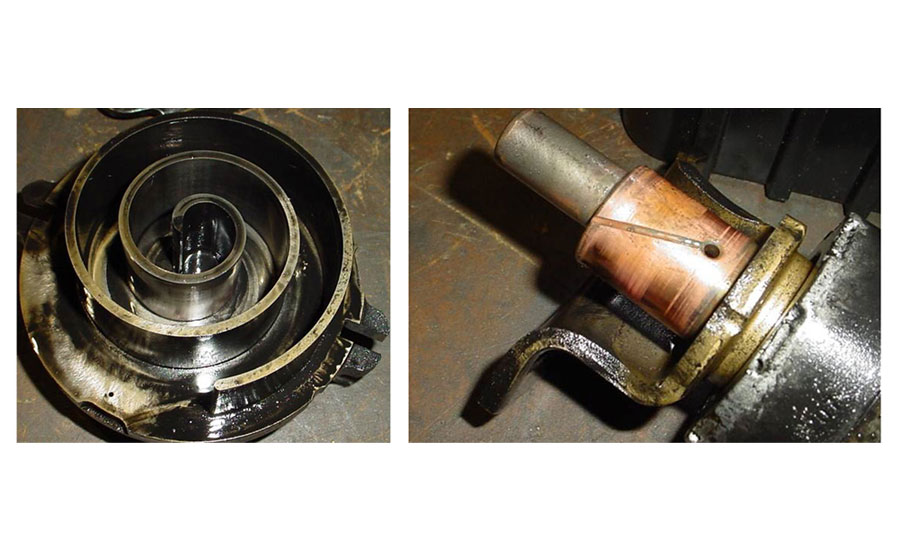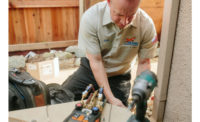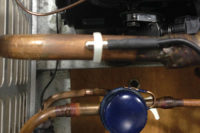Compressor failure can be traced to a number of system issues, including high condensing pressures, refrigerant floodback, service or replacement issues, a loss of charge, liquid slugging, motor burnout, and more.
Compressor burnout is a very specific mode of failure that may be caused by high temperatures in the motor windings or discharge area of the compressor. High temperatures break down the motor winding insulation, which may cause a loss of electrical resistance and result in a short to the ground or even an open winding.
If the oil breaks down, it can no longer provide adequate lubrication, which may cause the bearings or pistons to seize.
When a compressor fails, a comprehensive “autopsy” is necessary to properly correct the issue.
“Getting a system up and running after a compressor burnout requires certain steps that, if done correctly, may be the difference between years of trouble-free operation or only a few months before the replacement compressor also fails and needs replacement,” said Jamie Kitchen, a trainer at Danfoss.
CAUSES AND CULPRITS
According to Kitchen, the main causes of burnout are insufficient cooling from the suction gas as well as compressor operation outside of its application envelope. High condensing pressures are a common culprit. Since the returning gas (suction) provides a large portion of the cooling for the compressor motor, if there is not enough of it coming back as a result of a loss of charge, or if the superheat value of the gas is too high, the motor will not have enough heat removed from it and will overheat. Common causes of high condensing pressure are undersized and/or dirty condensers, failure of the fan motor, incorrectly set or inoperable fan controls, or recirculation of the condenser leaving air. All of these should be checked during the startup and commissioning phase.
Kitchen offered five steps to follow when starting up and commissioning a system after a compressor burnout.
“These steps will eliminate the vast majority of the reasons compressors fail, regardless of what did them in,” he said.
1) It is important to realize that not all burned out compressors are acidic. This is a holdover to the days when all refrigerants were chlorinated and compressors were charged with mineral oil. These systems could produce acid simply by overheating.
“With today’s hydrofluorocarbon [HFC] refrigerants and polyolester [POE] oils, it is impossible to produce acid without the presence of moisture,” Kitchen said. “Always verify that the oil is acidic by using the correct oil test kit before spending a lot of time and money treating the system as if it were acidic.”
2) Regardless whether or not the system is acidic, there will likely be burned oil, winding insulation, and possible other contaminates in the system. Flush the system using a flush approved by the manufacturer while making sure to remove the TXV so that contaminates are not flushed into it. Ensure the evaporator and condenser are flushed so that the flushing agent comes out clean when done. Kitchen advised that this process should be repeated for all other refrigerant lines. This will remove residual oil that could be holding contaminates, which, if left in the system, can come back to plug up the unit and contaminate the oil in the new compressor.
3) If the compressor was part of a parallel compressor group, and therefore shares the same suction and oil equalization with other units, be sure to inspect the oil in the other compressors and look for discoloration. Discoloration can mean that burned oil may have made its way into the other compressors or that they were operating too hot. If this is the case, then the oil in the other compressors will also need to be replaced.
“If the oil in the failed compressor is acidic, the oil in the other compressors will be, as well; however, this does not automatically mean they will need to be replaced,” Kitchen explained. “If the winding insulation checks out fine, replace the oil with new oil. The system flush will make sure that all contaminated oil is eliminated from the rest of the system.”
4) According to Kitchen, if the system was not acidic, then, once the system has been flushed clean, a good liquid line drier with activated alumina and molecular sieve desiccant will work fine. However, if the system was acidic, then the further steps of installing a suction line and acid removing drier are required. This is especially true if the refrigerant in the system is chlorinated as the type of acid produced by it can adhere to surfaces inside and take a while to fully come out. Plus, the chlorinated refrigerant will act as a catalyst to further acidify the new oil.
“Remember that suction driers are not install-and-forget devices. If residual acid is present in the system, it will cause a pressure drop in the drier, which needs to be monitored,” he said. “If a pressure drop occurs, a new drier will need to be installed. This will need to be continued until the plugging and resulting pressure drop stops.”
5) Finally, it is paramount to remember that the whole purpose of commissioning is to catch anything that may impact the proper operation of the system and its components. Do not be distracted by the fact that the system burned out or is acidic and miss the very issue that resulted in the failure in the first place. What if poor voltage to the compressor caused it to overheat, resulting in winding or oil failure? How do you know until you check for it? Unless it is corrected, the new compressor will soon fail, as well. This also goes for poor oil return or short cycling. Refrigerant leaks and improper evacuation can also result in compressor burnout. In other words, following proper installation and startup procedures is crucial.
“When done properly and when combined with the special considerations for a burnout discussed in this article, proper installation and startup procedures can help ensure that a compressor will operate properly for years to come,” Kitchen said.
FROM THE FIELD
Randy Hamilton, technical advisor and comfort consultant for GAC Services, Gaithersburg, Maryland, agrees that determining the cause of a compressor burnout is an essential part of any post-burnout cleanup.
“If you just replace the compressor, weigh the charge in, and then turn around and leave, you’ll never be sure what caused the problem,” he said. “We always want to get an idea what created the compressor failure in the first place.”
Hamilton said GAC Services performs a duct airflow calculation to ensure the system is being supplied with the proper amount of return air. Proper airflow can reduce the stress on a compressor and prevent slugging. The duct calculation can be done while the vacuum pump is running, he noted.
GAC’s technicians also spend a little extra time analyzing the system’s components.
“We might do a stress test of the TXV and put the sensing bulb in some hot or cold water to make sure it’s performing properly,” Hamilton said. “Then, once we fire up the new compressor, we do a complete system analysis to make sure everything’s performing correctly.”
Finally, Hamilton advised technicians who are dealing with a system cleanup to either pull and drain or replace the accumulator tank.
“There’s usually a lot of old oil from the compressor failure in the accumulator,” Hamilton said. “Even if you evacuate the system to remove the moisture and contamination, you can still have some of that old oil in the accumulator and end up sending contaminants through the system when you start-up the system.”
Changing the accumulator not only eliminates the potential for contaminants to be reintroduced into the clean system, it can also save time, especially if it’s done at the beginning of the process.
“If it’s winter and you’ve got some extra refrigerant in an accumulator tank, it can be a real drag to evacuate it all,” Hamilton said. “You might be there for hours. Sometimes, just replacing the accumulator at the beginning of the process allows you to reduce your vacuum time so much that it pays for the cost of the new tank.”
ADDITIONAL TIPS
Kelsey Poe, director of marketing and sales, CMP Corp., offered three additional helpful tips for cleaning a system after a compressor burnout:
• Inspect all valves, including expansion valves, solenoid valves, check valves, and reversing valves. Clean and replace them if necessary;
• Remove and replace the filter driers already installed in the system. For system-cleaning purposes, install an appropriately sized filter drier in the suction line and an oversized filter drier in the liquid line. After all cleaning procedures are finished, install a properly sized filter drier in the liquid line and remove the suction line filter and replace with a permanent filter; and
• Take an oil sample from the replacement compressor just after installation. Put that in a small glass container and set it to the side. After your replacement unit has operated for 48 hours, check the color and smell of the oil. Compare it to your original sample. Look for discolored or acrid-smelling oil and use a moisture indicator to see what the moisture content is in your system. If you find acid or a high moisture content, change the filter driers again. Allow the system to operate for two more days and re-check. Repeat this process until the oil is the same color as your original sample and free of any odor.
STEP BY STEP: REPLACING AN HVACR COMPRESSOR
Darrel Yashinsky, president, Air Quality Dunrite, Concord, Ontario, Canada, shared the steps his company recently took when replacing a customer’s burned out compressor:
We recently helped a customer who had experienced a compressor burnout. We discussed options regarding repair or replacement. Because of the complexity of the system and the cost for a new unit, the customer opted for a compressor replacement.
This system is used for pool heating and rejects heat to the pool. When the pool water temperature is satisfied, the unit rejects heat to an in-ground loop.
To ensure as long a life as possible, we tested the compressor and found it grounded out. A grounded compressor does not indicate a burnout but is a strong indication of a significant problem. We performed an acid test on the refrigerant and found it to be slightly acidic. We elected to clean up the system using a suction filter dry-out kit. We then power-washed the dirty evaporator coil and checked water flow through both condenser loops. To prevent future problems, we also ran descaler through the condenser loops.
We pumped out the refrigerant and installed a catch-all filter-drier shell with a burnout core and then installed an access valve on the gauge port to measure pressure drop across the drier. Next, we installed an oversized liquid-line drier.
After all that was done, we replaced the compressor. We then pumped the system down for 24 hours to pull a deep vacuum before recharging the system with virgin refrigerant per the manufacturer’s recommendation. We then checked the superheat.
The next step was to let the unit run for 24 hours and recheck for acid and pressure drop across the new suction drier core. After that, we ran the unit for 48 more hours and performed another acid check. No acid was present, so we replaced the acid core with a standard core. However, to be safe, we wanted to continue to monitor the system, so we returned after one week to test for acid again. We found no acid or significant pressure drop across suction filter, so we removed the filter and installed a felt element in the core.
The system has been running well for the past 90 days. We will recheck it during regularly scheduled maintenance.
Publication date: 3/27/2017
Want more HVAC industry news and information? Join The NEWS on Facebook, Twitter, and LinkedIn today!








